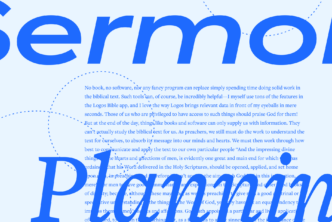Logos Bible Software 3 offers syntactic databases for the Hebrew Bible and for the Greek New Testament. Some of these resources (the Andersen-Forbes Analyzed Text and Phrase Marker Analysis and also the OpenText.org Syntactically Analyzed Greek New Testament) are informed to one degree or another by linguistics.
I can hear the feedback now: “Huh? Linguistics? Why? Isn’t syntax just syntax? You mean I need to learn about linguistics too?!”
David Alan Black, in his helpful book Linguistics for Students of New Testament Greek, describes the importance of linguistics for students of New Testament Greek in this way:
When we study linguistics we are learning how to put the Greek language in its rightful place as a part — perhaps the most technical part — of our work in the text of the New Testament. Through exposure and practice, we can acquire a broader, more confident command of New Testament Greek. …But more importantly, the study of linguistics can contribute a great deal to our understanding of the meaning of the New Testament. It can help us become more aware of why we understand a text the way we do when we read it, and it can help us talk about the text more precisely, by providing us with a methodology through which we can show how interpretation is in part derived from grammatical considerations. Linguistics may also help solve problems of interpretation by showing us why one meaning is possible but not another. Above all, however, linguistics can give us a point of view, a way of looking at a text that will help us develop a consistent analysis, and prompt us to ask questions about the language of the text that we might have otherwise overlooked. (Black 3, emphasis mine)
I’ve highlighted the final portion of the quote because it describes so well one of the primary ways in which the syntax graphs (more on graphs here, here and here) for both the Hebrew Bible (more here) and the Greek New Testament (more here and here) can be used in one’s study.
Much of the information about linguistics is already dealt with in the encoding of the databases. The syntax graphs merely make the underlying information explicit. They give you a picture to visualize the linguistic goings-on, here described mostly in terms of syntax.
The bottom line is if you start to read the text using the syntax graphs, a few things will happen.
- First, you’ll slow down and take a look at the bigger picture.
- Second, you’ll see clause structure (verbs, subjects, objects, etc.) that you likely would not have seen just reading through a paragraph of original language text.
- Third, you’ll begin to look across passages for, say, what sorts of things (objects/complements/adjuncts/adverbs/prepositional phrases) further modify verbs (predicators) to track action through a passage. You’ll start to look at subjects to see if the subject is the same, or if it changes.
- Fourth, as you begin to look at the text in this different way, you’ll have different cues to remind you of things you’ve seen before.
- Fifth, as Black notes, you’ll start to develop the basis on which to ask further questions of the text. You’ll notice new, different things. And those new, different things will complement your study of the text.
All of it will help you draw connections — here formulated on the basis of syntax and linguistics — to complement other connections you’ve already made based on other reading, morphology, commentary, text-critical aspects, and the like. In short, slowly reading through the syntax graph (by all means read the normal text first, and read translations too!), keeping track of the text at a syntactic level as opposed to just words on a page draws on other influences and helps with developing a larger picture of what’s going on in a particular passage.




